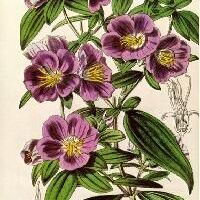Herbs or shrubs, 20-100 cm tall, erect. Stems 4-sided, appressed strigose. Petiole very short or up to 1 cm, strigose; leaf blade linear, linear-lanceolate, oblong-ovate, elliptic-ovate, or sometimes ovate-lanceolate, 2-5(-9) × 0.3-1(-3.2) cm, stiffly papery, both surfaces strigose, secondary veins 1 or 2 on each side of midvein, tertiary veins inconspicuous, base obtuse, subrounded, rounded, or subcordate, margin entire, apex acute. Inflorescences terminal, capitate, 2-8-flowered, with 2-6 bracteal leaves at base; bracts sessile, ovate, pubescent or adaxially glabrous. Hypanthium usually pink, 6-6.5 mm, glabrous or 1-5 setose tuberculate. Calyx lobes 4(or 5), triangular-lanceolate, margin ciliate, setose between lobes. Petals 4 or 5, pink to pale purple, obovate, 1-1.5 × ca. 1.3 cm, margin ciliate, apex apiculate or rounded. Stamens 8 or 10, inclined to one side; filaments as long as anthers; anthers narrowly lanceolate, beaked; connective bases slightly inflated. Ovary subglobose, 4-or 5-celled, apex densely setose or strigose. Capsule purplish red, ovoid-globose, ca. 6 × 4 mm, glabrous or setiform tuberculate.
More
A small erect shrub. It grows 1 m tall. The stems are hairy and 4 sided. The leaves are broadly oval or sword shaped. They are 1.8-3.2 cm long by 0.8-1.2 cm wide. There are slight teeth along the edge. The leaf stalks are 1-2 mm long. The flowers have 5 petals. They are pink or pale purple. The fruit are 7 mm across and 6 mm long. They are purplish red.

